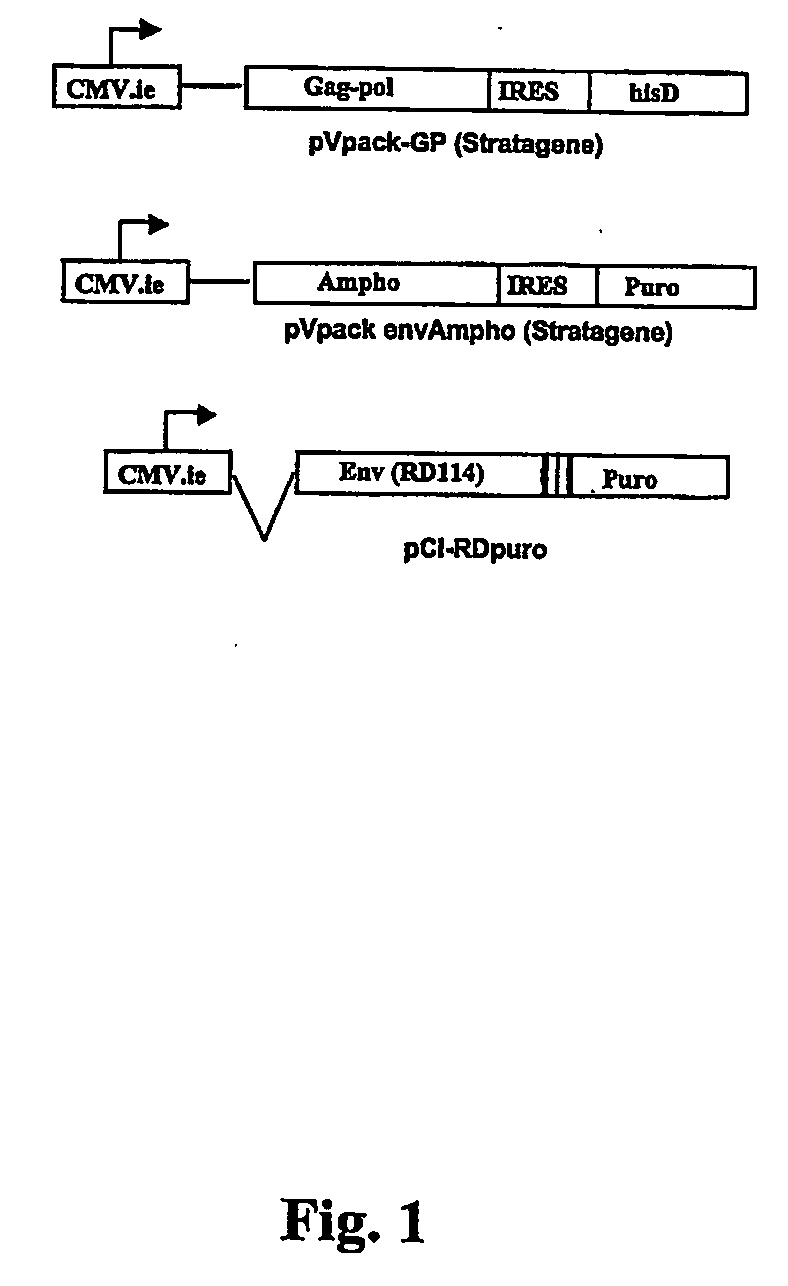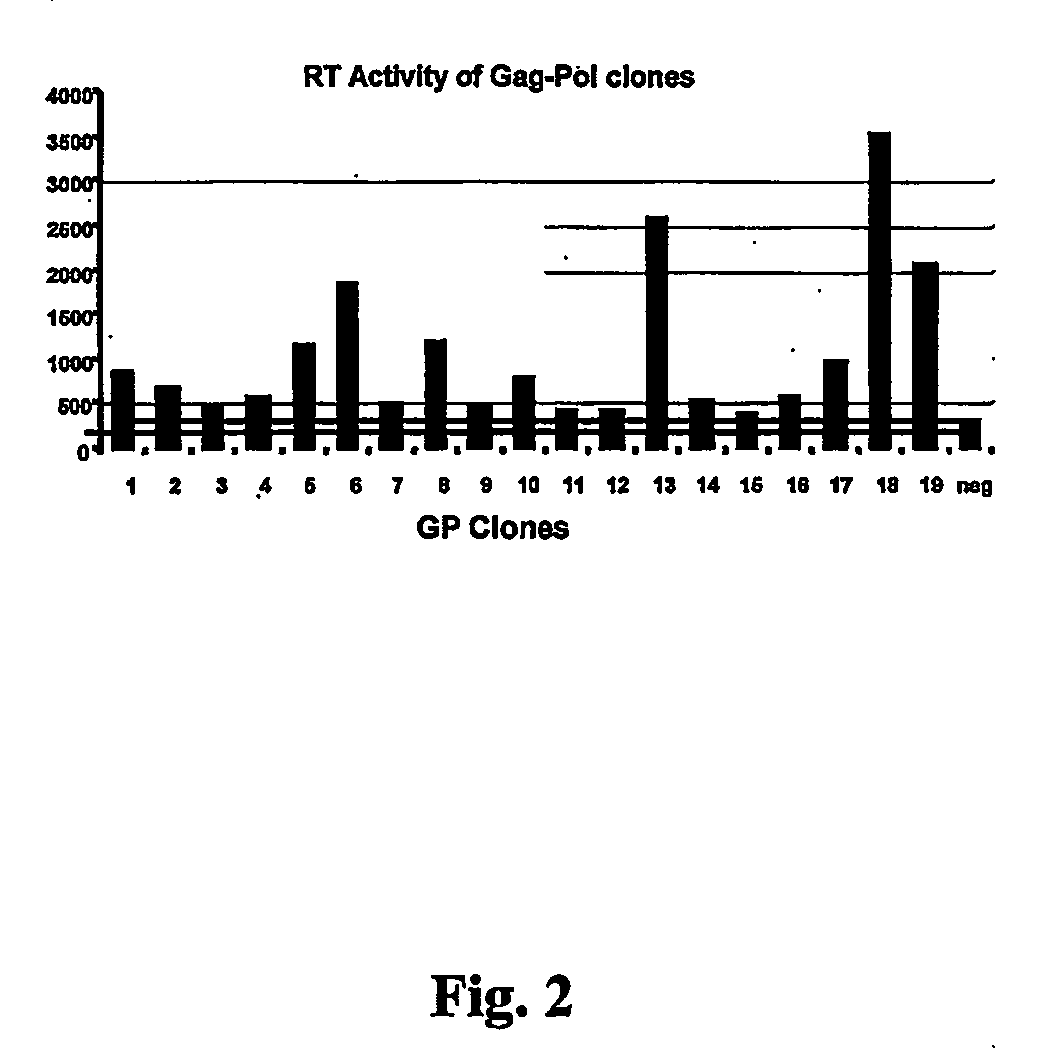High-titer retroviral packaging cells
a technology of retroviral packaging and packaging cells, which is applied in the direction of viruses/bacteriophages, genetic material ingredients, genetically modified cells, etc., can solve the problems of cumbersome production of large retrovirus volumes, difficult production of retroviruses, and inability to generate replication competent retroviruses
- Summary
- Abstract
- Description
- Claims
- Application Information
AI Technical Summary
Benefits of technology
Problems solved by technology
Method used
Image
Examples
example i
Construction of the pCI-IRDpuror Plasmid
[0055] The RD114 env expression plasmid is constructed as follows: a 2003 bp HindIII / ApaI env fragment from a RD114 infectious virus clone, SC3C, is treated with the T4 DNA polymerase to blunt both extremities of the DNA fragment as currently known in the art. The blunted fragment is then cloned in the SmaI restriction site of the polylinker site of a pCI vector (Promega), to generate a pCI-RD114 plasmid (pCI-RD). This plasmid is further used to construct a pCI-RD plasmid comprising a selection marker. For the purpose of the present invention a gene encoding for a resistance to puromycin was chosen (puror). Puromycin is an aminonucleoside antibiotic produce by Streptomyces alboninger that inhibits in eukaryotic, as well as prokaryotic cells. The puror gene encodes a puromycin N-acetyl-transferase (PAC) that confers resistance to mammalian cells. The pCI-RD plasmid comprising the puror gene (pCI-RDpuror) was constructed is follow: a 670 bp pur...
example ii
Obtention of a 293SF Cell Line Stably Expressing Murine GAG and POL Genes and Feline RD114 ENV Gene
Material and Methods
[0056] 293SF cells were cultured in Dulbecco's modified Eagle's medium transfected and maintained in a medium complemented with 10% fetal calf serum and antibiotics. 293SF cells were then transfected with the pVPack-GP vector (Stratagene) by the calcium phosphate procedure. This vector comprises gag and pol genes from the Moloney murine leukemia virus. To obtain the clones that stably expressed both genes, cells were selected with histidinol (250 mM) for two weeks. The pVPack-GP (FIG. 1) plasmid includes a histidinol resistance gene, histidinol dehydrogenase (hisD), that allows cells having incorporated the vector into their genome to survive histidinol treatment.
[0057] The histidinol-resistant clones were isolated and an analysis of the expression of gag and pol genes was assessed by measuring the expression level of reverse transcriptase (RT). The presence of ...
example iii
Expression of an Exogenous Gene in GRPD Cell Line
[0059] One day prior to transient transfection, 3×105 cells from each GPRD clones were plated in 6-well plate. Each clone was individually transfected by the calcium phosphate procedure with 6 μl of pNC-Luc. The pNC-Luc retroviral plasmid used to screen GPRD clones is derived from a Moloney murine leukemia vector which has a neomycin resistance gene (Neo), under the control of an internal CMV promoter.
[0060] The next day, 1 ml of each transfected clone was harvested and used to infect HT-1080 cells in the presence of 8 μg / ml polybrene. The target cells had been plated the day before at a density of 3×105 cells per well in 6-well plates. A luciferase assay was performed one day after infection of HT-1080 cells, and also an GPRD clones at the time of the supernatant harvest to normalize the transfection efficiency. Cells were trypsinized, washed twice with PBS, resuspended in 0.25 M Tris-HCl, pH 8.0 and cell extracts were obtained by ...
PUM
| Property | Measurement | Unit |
|---|---|---|
| Nucleic acid sequence | aaaaa | aaaaa |
Abstract
Description
Claims
Application Information
 Login to View More
Login to View More - R&D
- Intellectual Property
- Life Sciences
- Materials
- Tech Scout
- Unparalleled Data Quality
- Higher Quality Content
- 60% Fewer Hallucinations
Browse by: Latest US Patents, China's latest patents, Technical Efficacy Thesaurus, Application Domain, Technology Topic, Popular Technical Reports.
© 2025 PatSnap. All rights reserved.Legal|Privacy policy|Modern Slavery Act Transparency Statement|Sitemap|About US| Contact US: help@patsnap.com



